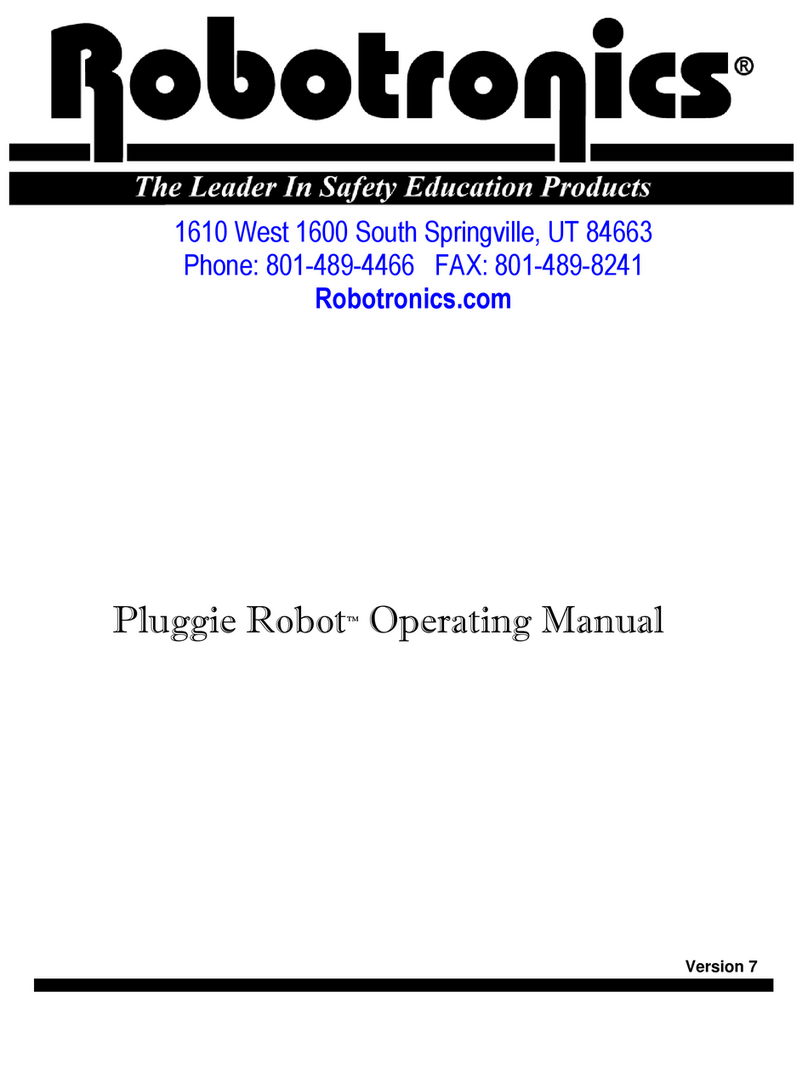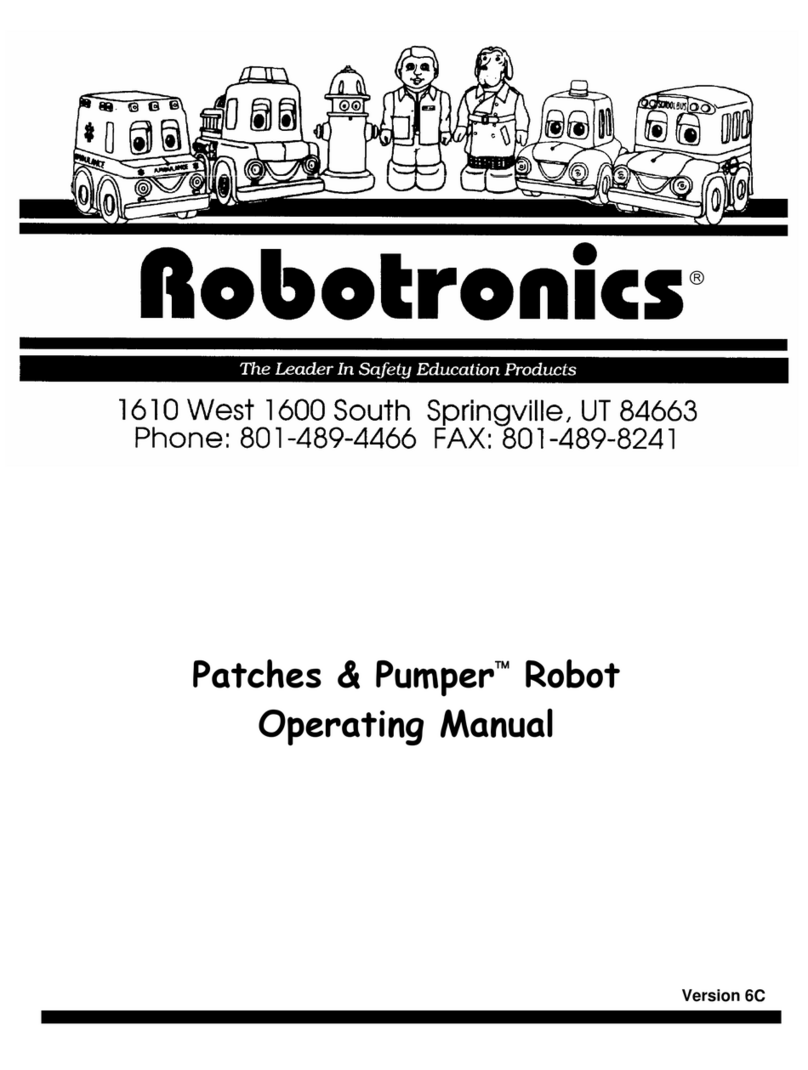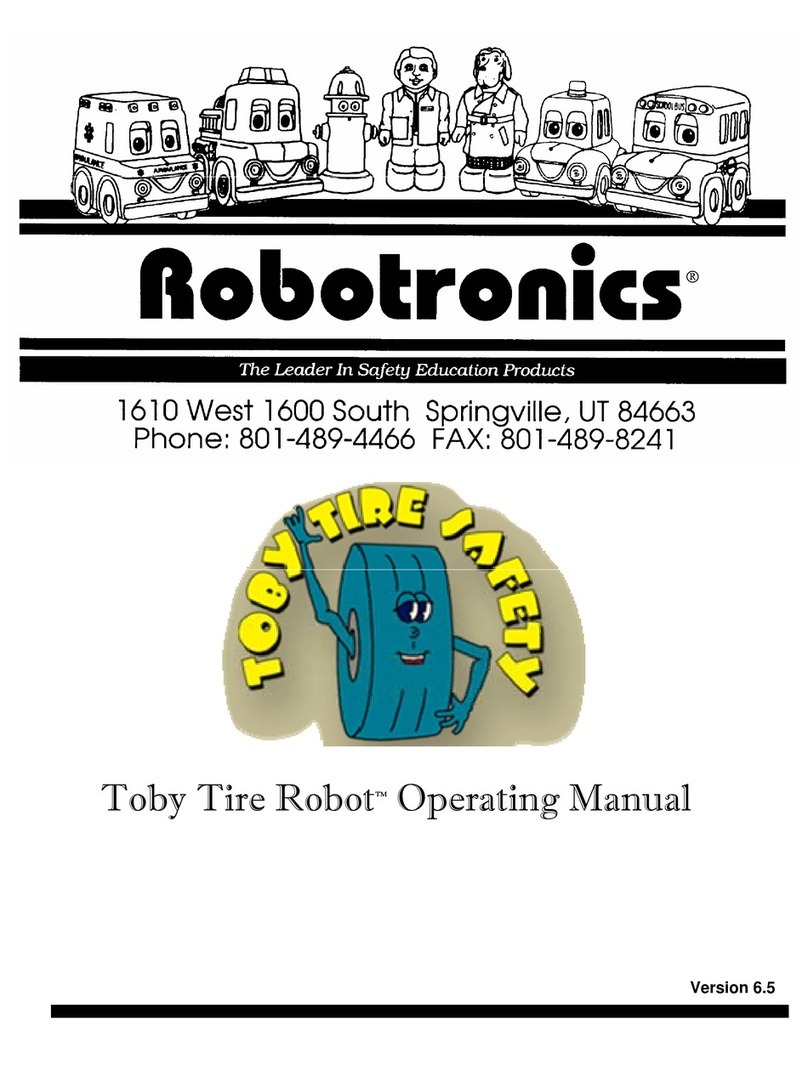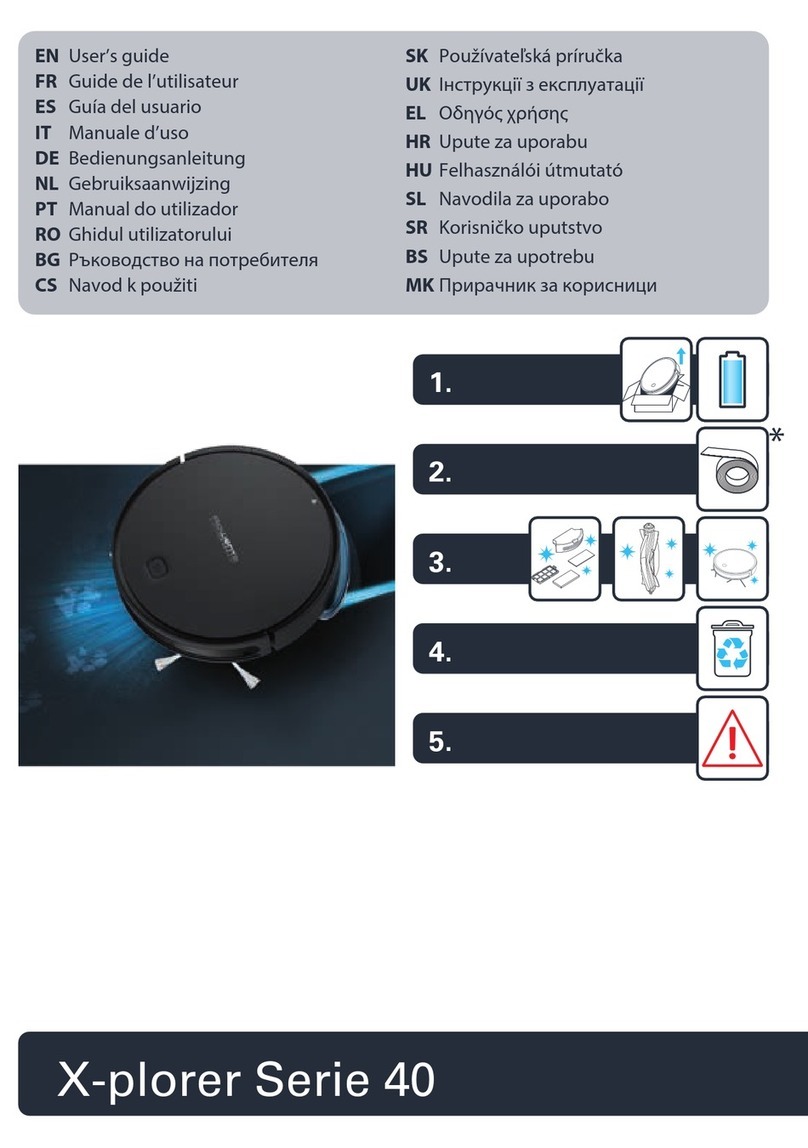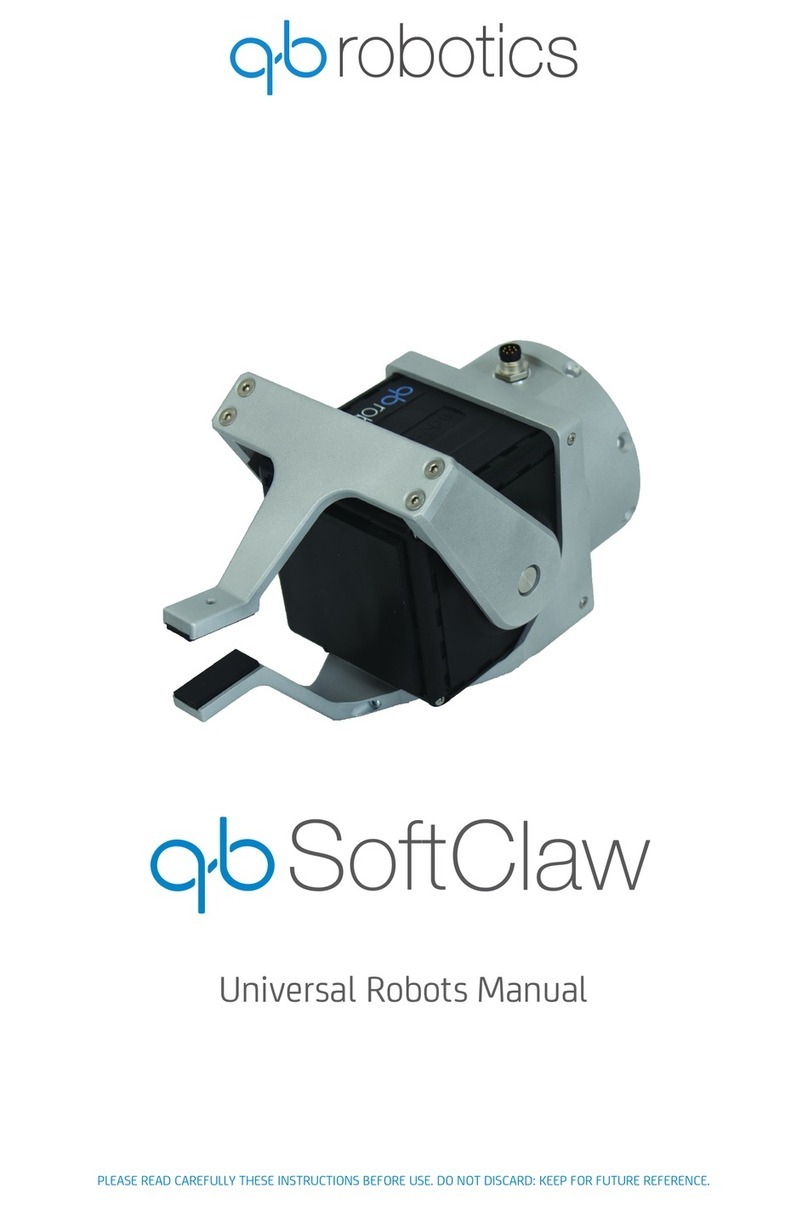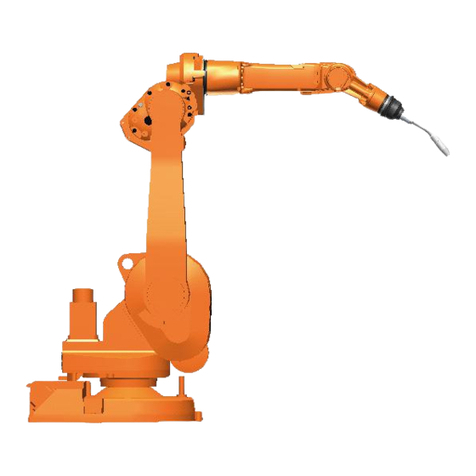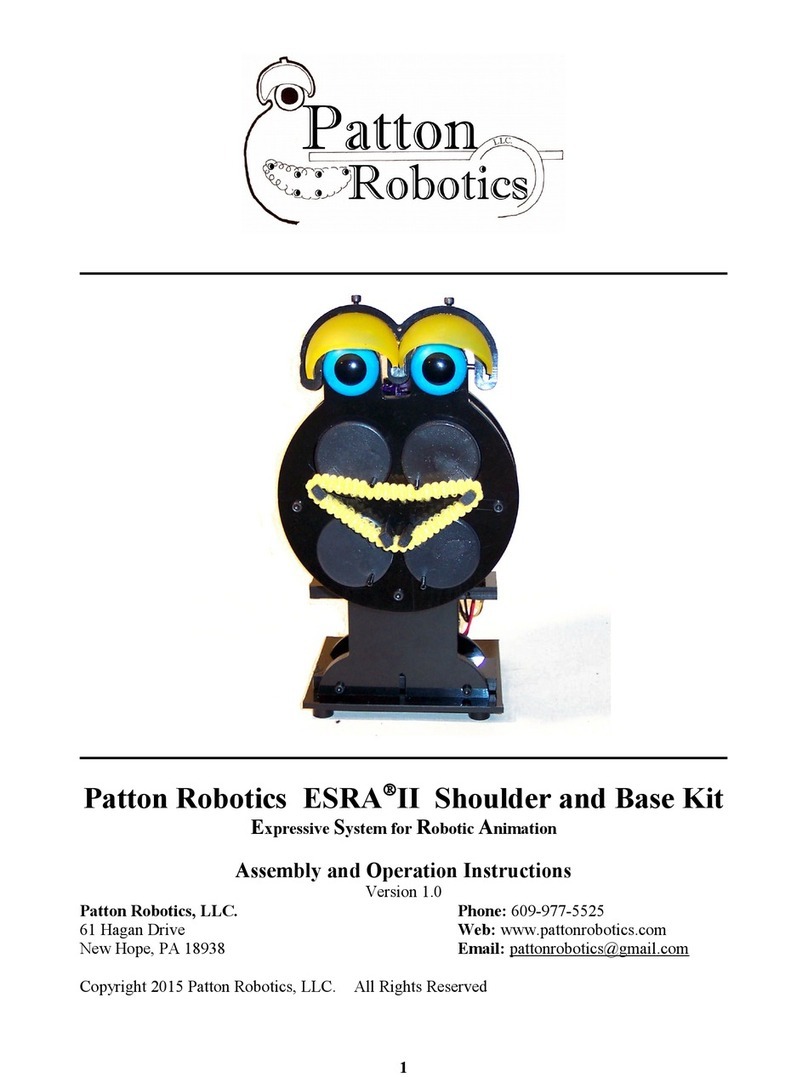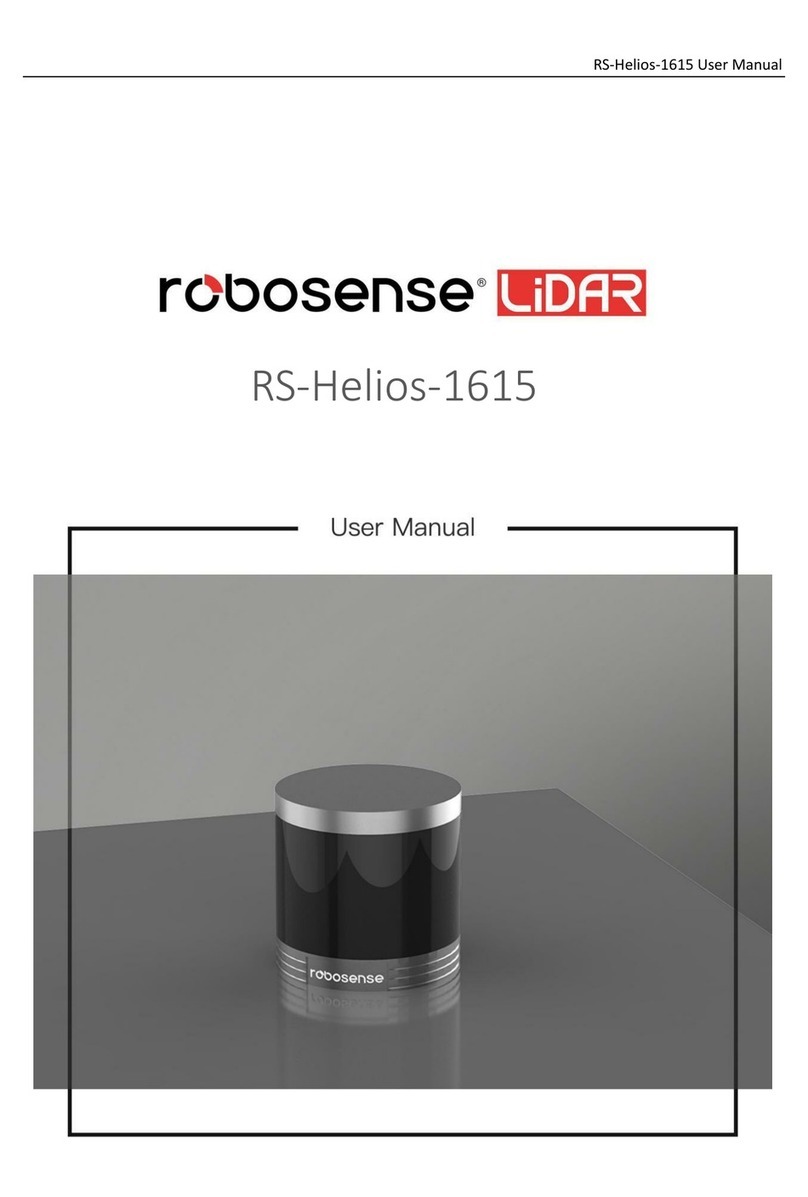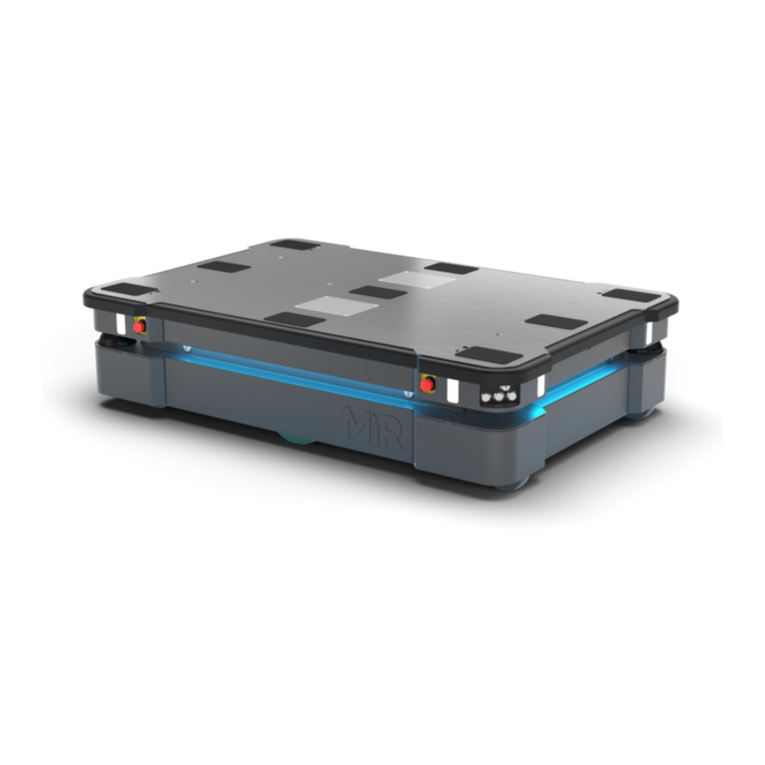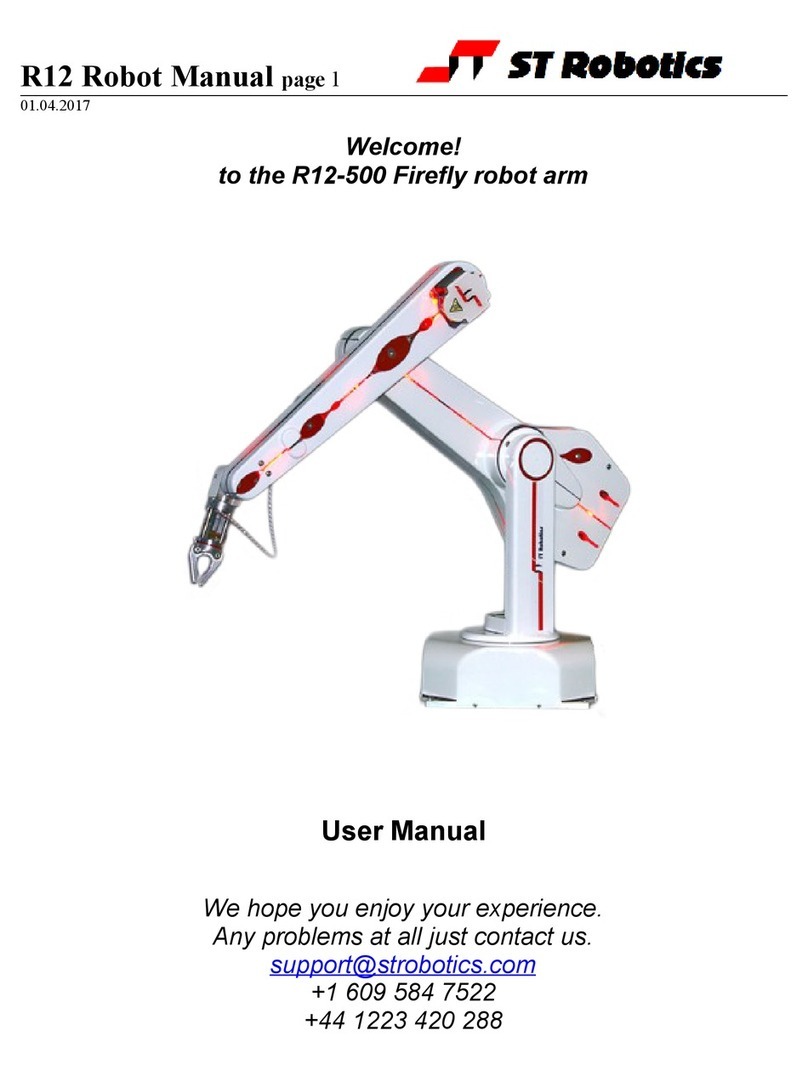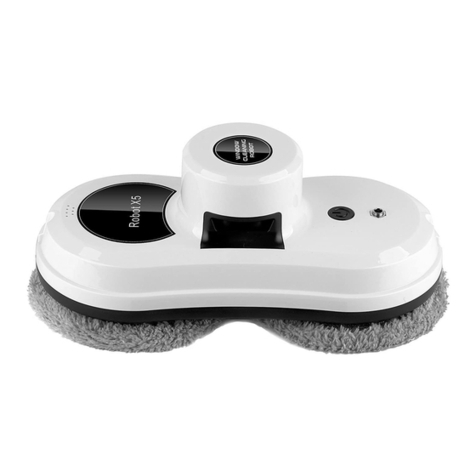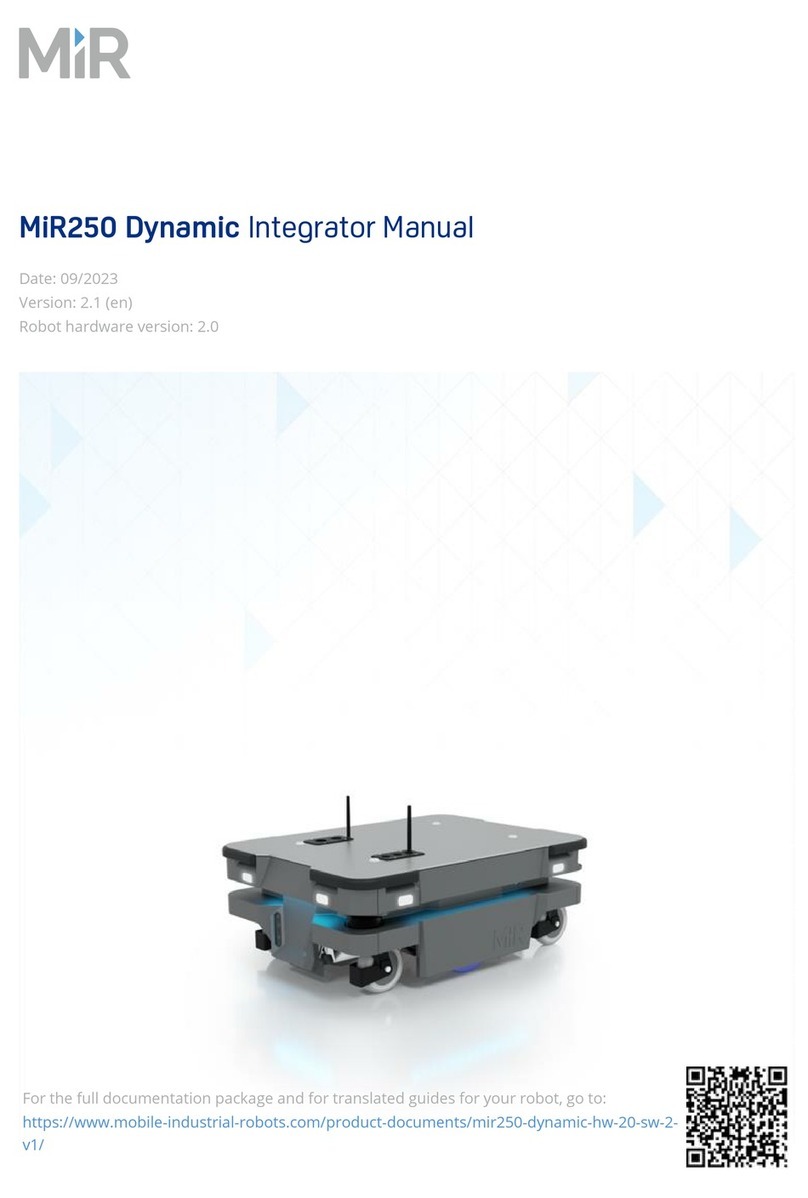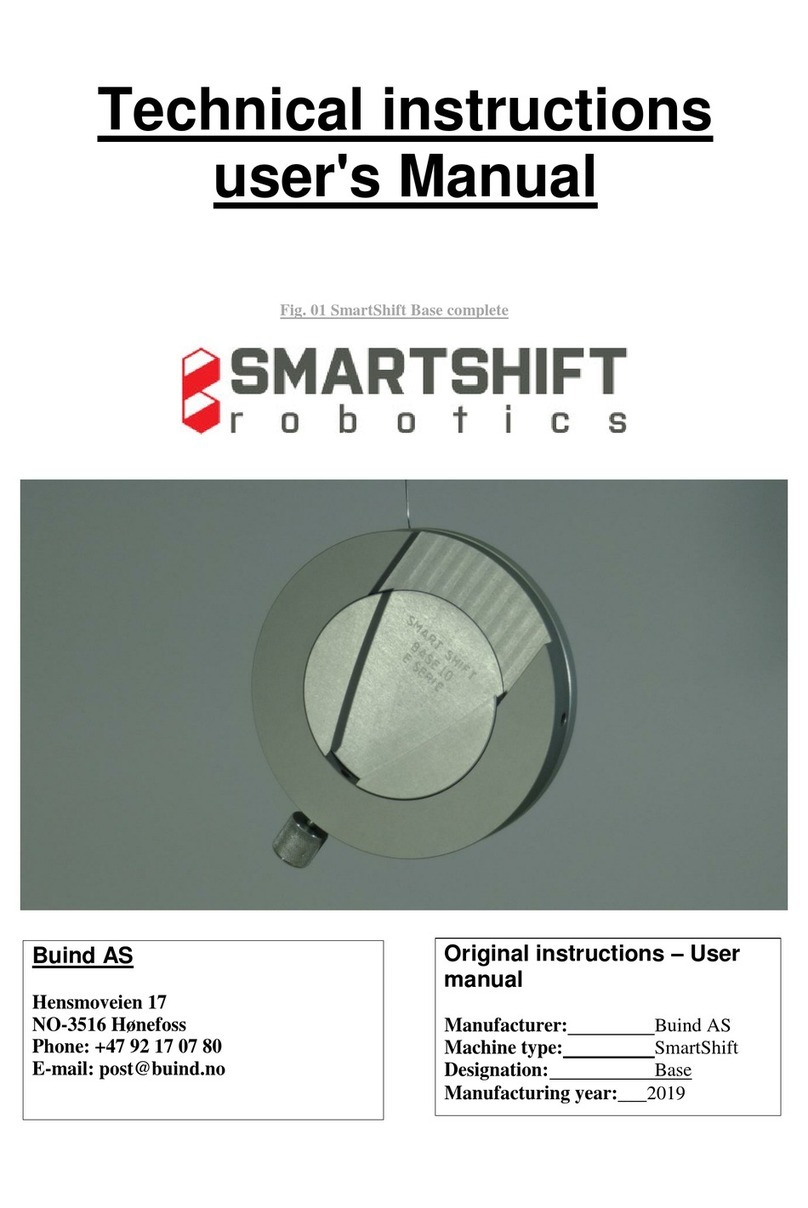Robotronics Vehicle Robot User manual

i
Vehicle RobotOperating Manual
1610 West 1600 South Springville, UT 84663
Phone: 801-489-4466 FAX: 801-489-8241
Robotronics.com
V
ersion 6.6

ii
Vehicle Operating Manual
Congratulations on your purchase of a ROBOTRONICS, Inc. robot.
Your robot has been carefully constructed of the highest quality components. Its
design is the result of years of experience building robots. You will find it an
extremely effective spokesperson for safety and your organization. It is built for
ease of operation, maintenance and repair. It is built so that you can easily expand
its functions making its value grow as your needs grow.
Please read this manual carefully. It will help you make the most of your
robot. Attention to maintenance and proper training will greatly prolong the life of
your robot. Train users to take care of the robot and keep the robot covered and
indoors. Most problems you encounter will be minor and the manual will provide
an answer. Please feel free to contact us if you have unanswered questions relating
to operation, maintenance, and repair. Call 801-489-4466. Also, if you have
technical questions relating to expanding the functions of your robot, we would be
happy to help.
Sincerely,
ROBOTRONICS, Inc.
ROBOTRONICS INC.
Springville, Utah 84663
www.Robotronics.com
Robotronics Inc., 2009.
Robotronics

iii
Contents
Warranty Information .............................................................................................. 1
PART 1 General Operating Instructions..........................................3
Chapter 1 Getting Started......................................................................3
Operating Tips and Safety Information .................................................................3
Setup and How to Operate The Robot..................................................................4
Transporting the Robot .........................................................................................7
PART 2 Subsystems of the Robot......................................................8
Chapter 2 Radio Control System...........................................................9
Radio Control Operating Instructions.................................................................... 9
Radio Control Transmitter (Diagram)..................................................................10
Radio Control Transmitter Controls.....................................................................11
NI-MH R.C. Transmitter Battery..........................................................................13
Charging of the NI-MH R.C. Transmitter Battery (Diagram)................................14
Adapter for Charging...........................................................................................14
Chapter 3 Voice System Overview......................................................15
Location of Voice Units ....................................................................................... 15
Belt Transmitter...................................................................................................16
Robot Receiver ...................................................................................................17
151 System (Robot TX and Belt 151 Receiver) ..................................................18
Voice System Troubleshooting ...........................................................................19
Mouth Operation.................................................................................................21
Operator’s Voice Headset, Transmitter, and Receiver........................................22
Chapter 4 Audio Amplifier ...................................................................23
Chapter 5 MP3 Player...........................................................................24
Chapter 6 Cassette Tape Player System ............................................26
Chapter 7 Siren.....................................................................................27
Chapter 8 Robot Battery Systems.......................................................28
Robot Battery ......................................................................................................28
Robot Battery Charger ........................................................................................ 29
Chapter 9 Drive Motor System ............................................................31
Chapter 10 Character Head Turning Motor System...........................33
Chapter 11 Eyelids and Eyes Left and Right......................................34
Contents

iv
Chapter 12 Optional Accessories
Water Squirter System........................................................................................36
Water Squirter System Diagrams........................................................................36
Pitch Shifter (Voice Modifier)............................................................................... 37
Stop Arm Option – Bus .......................................................................................39
Crossing Arm Option – Bus.................................................................................40
PART 3 Assembly & Disassembly................................................41
Chapter 13 Assembly & Disassembly.................................................41
PART 4 Maintenance................................................................................ 43
Chapter 14 Maintenance ......................................................................43
Regular Maintenance Checklist ..........................................................................43
Recommended Tool Kit.......................................................................................44
Care of Character Fur .........................................................................................45
Painting of the Body............................................................................................ 46
Repair of the Body ..............................................................................................47
Storage................................................................................................................ 48
Appendices
Appendix A..............................................................................................49
QUICK REFERENCE TROUBLESHOOTING .............................................50
Robot Circuit Block Diagram...............................................................................53
Appendix B Robot Parts Identification...............................................54
Robot Frame Top View 1 .................................................................................... 55
Robot Frame Top View 2 .................................................................................... 56
Main Electronics Box/Panel ................................................................................57
Vehicle Main Electronics Board ..........................................................................58
Led Functions on the Main Board .......................................................................59
Vehicle Fuse Block Detail ...................................................................................60
Robot Frame Bottom View-Motor Pulley Set Screws..........................................61
Vehicle Top 1 Underside View............................................................................ 62
Vehicle Top 2 Underside View............................................................................ 63
Eyes Servo Board ............................................................................................... 64
Character Head-Inside View ...............................................................................65
Character Top Underside View...........................................................................66
Character Top 2 Underside View........................................................................67
Character Head Turning Parts Detail..................................................................68
Character Control Board Type 1 ......................................................................... 69
Character Control Board Type 2 ......................................................................... 70
LED Light Bar (Available on certain robots)........................................................71
37 Pin Connector Pinout .....................................................................................72
Appendix C Maintenance Forms.........................................................73
Checklist Form ....................................................................................................74
Maintenance Form ..............................................................................................75
Notes Section...................................................................................................... 76
Contents

1
Limited Warranty
All robots and accessories have a limited one year warranty, which covers all parts and labor.
This period covers the normal burn-in for electronic components. Experience has shown that
this warranty period catches most component defects and other possible flaws. If you have a
problem, we are anxious to help. Our desire is to be certain you receive a quality product and
excellent service.
Warranty work is specifically limited to correction of defects by repair or replacement of faulty
equipment or parts. The robot or part shall be repaired or replaced at Seller's option.
Equipment returned to the factory for repair must have pre-authorization from our service
department and must be sent freight pre-paid, and will be returned freight pre-paid by UPS
ground or common carrier. If you need parts returned by air shipment, you will be responsible to
pay the additional shipping charges. The end user is responsible to contact our service
department about any problem and install replacement parts or make adjustments if needed on
the robot.
In no event shall ROBOTRONICS, Inc. be liable for any incidental or consequential damages in
connection with or arising from the use of the robot, this manual or any procedures herein.
The buyer is further responsible to ensure that proper and complete training is given to those
operating the robot system as all aspects of such operation cannot be covered in a brief manual
such as this.
If You Have a Problem Call Service 801-489-4466
Call our service department and explain the problem. Most difficulties are minor and can
be solved easily over the phone. If possible, have the robot near the phone when you
call.
Important: Have the robot serial number and model number ready. This will help our
technician identify the model of robot you have. The serial and model number sticker is
located on the robot frame on the right side. In the Appendix, the Lower Robot - Top
View shows the location of the serial number sticker
Have the robot near the phone so that we can help you immediately.
Record the vital information from your robot here for future access
DateReceived:
CustomerNumber:
Robot Model Number:
Robot Serial Number:
Brand of Radio Control:
Frequency of Radio Control:
Voice Frequencies
Operator Transmitter:
Operator Receiver:
Warranty

2
If you need to send a part back to Robotronics for repairs
Go to our website, Robotronics.com and under the service tab find the return form. Fill
this out and send it back with the part or robot.
If you have saved the robot boxes and packaging this will make it easier to return the
robot.
Call the service dept. before shipping the robot or part back to the factory. Pack it
carefully and send it prepaid.
Parts of the robot are best sent by a carrier such as UPS, FedEx. or U.S. mail. A freight
company can be used to ship the entire robot. Be sure to insure the shipment for the
correct value.
For international shipments, you will be responsible for paying customs duties, taxes and
other fees. The shipment must be labeled on the paperwork and on the outside of the
container that it is “For Educational Purposes”. If it is a “warranty replacement” or a
“repair return” this also must be indicated both ways on the customs documentation.
Contact your customs agency on how to document the shipment correctly to avoid
unnecessary customs charges.
After The Warranty Repair and Help
Our technical staff is always available to help with your questions. Again, most problems are
easily solved. The robot design is very modular to make removal of a part of the robot very
easy. For example the main electronics box, which houses most of the electronic circuitry, can
be removed from the frame of the robot. If you do need technical help or replacement parts, call
our Service Dept. We can usually ship them the following day you call.
Service Department phone number: 801-489-4466.
What’s Available on our Website
Parts for your robot: Our website contains a parts listing with pricing for some of the parts of
the robot such as batteries, chargers, wireless voices, headsets, RC, lights, plastic parts, servo
motors, drive motors etc. For any other parts, give us a call.
Maintenance and repair information: If your robot ever needs maintenance work to be done,
you can send a part or the complete robot to Robotronics. The website contains information
about packaging and shipping. There is a return form on the internet to fill out to print and send
with your part.
Photo gallery of other robots: You can look at other robots and how they have been painted,
customized and decaled.
Program Support Material: Educational material to handout and reinforce your safety
message as well as music that can be used in the robot.
Warranty

3
Part 1 General Operating Instructions
CHAPTER 1 Getting Started
Operating Tips and Safety Information
ROBOTRONICS, Inc. robots are a unique and exciting tool in the hands of a skilled and trained operator.
The operator provides much of the excitement the robot conveys. The selection and training of the
operator should be done carefully, so as to provide a person with good judgment and an outgoing
personality. Nevertheless, with a little practice anyone can learn to operate the robot and even those with
a shy personality can be very effective using the robot. It is important that you observe the following
safety guidelines. Include this in any operator training. Practicing with the robot and having a program
outline or script will help you have success the first few times out.
The operator must have the radio control in their hands when the robot is on. If you need to
set the radio control down, turn the robot off first.
Always have a trained person (escort) near the robot for safety purposes, to help in crowd
control, and to protect the robot from vandalism. This person is also available to answer questions
and interact with the robot.
When using the robot on a stage, the area just in front of the stage should be clear of children
for at least 10 feet.
Neck Strap. There is a hook on the RC that you can attach a neck strap to. This will help prevent
drops.
Keep the robot indoors with the cover on when not in use. This will keep the robot clean and the
color at its best. Direct sunlight/UV light can fade the plastic over time.
You can paint the body if it fades or if you want to change the color of the body/trim. See the painting
instructions for tips.
Operate the robot with charged batteries in the transmitter and robot.
Never operate the robot out of line-of-sight.
Make sure trims (sliders) on the RC are centered prior to turning on the RC and the robot.
Operating distance should never exceed 100 feet. When moving the robot through crowds, the robot
should be operated slowly and smoothly without any sudden changes of direction. Walls, turns, and
other obstacles are hazards to be avoided. Never leave the robot "ON" when unattended or in direct
sunlight for extended periods of time.
The robot is designed to be operated on hard, smooth surfaces and carpet. Avoid extra deep shag
carpet, dirt, gravel, or grass surfaces. Avoid steep inclines or large uneven surfaces such as curbs,
gutters, or uncovered electrical lines.
If there are other radio controlled robots at the same event, confirm that they are not on the same
frequencies. See the diagrams showing your RC and wireless voices to locate these frequencies.
When attempting to operate the robot for the first time, do so in a large flat area without obstacles.
The operation of the controls should be done in a smooth, fluid manner. Avoid jerking starts and
stops or overreacting to the controls. When first practicing movement, it is sometimes helpful to
follow behind the robot, as robot movement will match stick movement. (Controls respond opposite
when the robot is facing the operator.)
The robot can be a highly successful tool for education and entertainment. Appropriate jokes, stories and
general conversation can be very effective. Children of all ages are strongly attracted to the robot. They
will talk to it, hug it, kiss it, and generally treat it as a good friend. The smaller sized robots are very
effective with children. They are light in weight and just the right size to communicate with children. The
most important ingredient to the use and effective operation of the robot is common sense. The following
instructions will help you get set up and start using the robot.
Getting Started

4
Setup and How to Operate the Robot
1 Read the manual
Read and study this manual completely before operating the robot. If you have any questions
about operation of the robot, call our service group.
2 Charge the batteries
Be certain that the robot battery and radio control transmitter battery are fully charged before
operating the robot.
Install the robot battery. Open the rear door or trunk to gain access.
1. Put the robot battery in the compartment in the back.
2. Connect the robot battery connector to the robot connector. Red will go to red and black to
black. This connection is polarity protected and can be connected only the correct way.
3. The battery is secured in place with a battery strap. Tighten the strap very tight.
CAUTION
The robot battery posts should never contact the metal of the main electronics box or the
metal of the drive base. This will result in damage to electronic components especially
inside the main electronics box.
3 Attach the upper robot to the lower
1. Set the upper robot on the lower robot body.
2. As you put the top on, connect the 37-pin connector, which is a round connector and wire
bundle running from the upper robot to the lower robot. When connecting this rotate it until it
sits down into its mate connection and turn the plastic ring until it is secure.
3. Locate the four body latches (just two on certain robots) and push
the pins into the body to secure the upper robot to the lower. If you
have a Character driving, two of the latches are located in the
compartment where the Character sits. The pins are to the left and
right of Character. The other two are at the back of the robot. To
latch these you will need to reach in through the back trunk or
door. If you want to see a picture of the latches see page 5.
Getting Started

5
CAUTION
Before operating the robot or transporting the robot on the cart or in a vehicle, the upper
robot must be properly latched to the lower by pushing the latch pins in. Failure to do
this could cause damage to the upper robot if it fell off.
4 Powering up
The radio control transmitter will be referred to as the “RC” in this manual.
Turn the RC "ON" first and then turn the robot "ON". Check that the RC
battery level meter reads to the right. The "ON/OFF" switch for the robot is
located inside the rear door or trunk on the main electronics panel. Push the
switch up to turn the robot on. On some robots there is a hinged rear door to
access this switch. Tip: There is a hook on the RC that you can attach a
neck strap to. You can use a RC or camera type neck strap.
5 Set the volumes
Check that the volume of the voice and MP3 player are at the level that your want. The volume
for the robot’s voice is can be adjusted on the UHF Wireless Receiver in the robot or on the
level adjustment on the Nady UB4 transmitter. If you have the tape player, adjust the volume on
the player itself.
Tip: If you want to change your voice volume quickly, move the mic closer or further from your
mouth.
Body Latches
Body Latches
Bod
y
Latches
Location of Body Latches for each style of top
Getting Started

6
Tip: To change the volume of the MP3 player hold the mp3 switch on while moving the left
joystick. There is a master volume on the Road Rage Amp. This amp is located on the main box
in the lower robot. This acts as a master volume, so after changing it you may have to re-adjust
the voice volume on the UHF Receiver in the robot. Do not go above the 1:00 position on the
amp level adjustment.
6 Test all the functions
Test all of the robot's functions: Character’ voice both ways, head turning, mouth, steering
wheel, eyelids, eyes, tape, siren, lights, and drive movement for proper operation. The robot is
now ready to operate.
Note: Keep the sliders on the RC centered and be sure they are centered before turning
on the robot.
7 Optional accessories setup
For information about these, see the optional accessories section. This includes options such
as the voice modifier and water squirter. These sections will give you step by step instructions
for setup and related diagrams. You can put your own music and even sound effects on the
MP3 player SD card. See the MP3 player section for details.
8 Powering down
1. Turn off the voice units that you wear on your belt before turning off the robot.
2. Turn off the robot.
3. Finally turn off the Radio Control Transmitter.
9 Charge the batteries again
Connect the Robot battery to the charger and bring it back to a full charge before leaving the
robot. This battery should not be left with a partial charge. The transmitter battery should be
charged if it is low. Before a storage period, charge both batteries to a full charge.
All of the major functions of the robot each have a section in the manual with more
details and diagrams. Refer to these for more in depth information. The Appendix
has pictures and diagrams of where various parts are in the robot. These will help
you become familiar with where the parts are located and their function.
For parts that you need for the robot, go to Robotronics.com. This includes radio
controls, voice units, headsets, batteries and chargers.
When doing programs in large open locations you may want to use a separate
wireless mic with a portable amp or the PA system. You can play music through the
main system and even do the voice of the robot if you have at least two mics. This
will take some practice to get it set up.
It is possible to use a cell phone headset with the two way voice system if you get an
adapter that goes from a 2.5 mm jack to two 3.5mm(1/8”) plugs. This will give some
added flexibility in choosing what type of headset that you can use.
Getting Started

7
Transporting the Robot
Before transporting the robot, remove the robot battery from the robot. The vehicle that you use
to transport the robot should have adequate shock absorption. Vans and cars used for
passengers would be the best. Transporting the robot in a trailer is not recommended because
trailers typically do not have the same level of shock absorption as a car or van. A good rule of
thumb to follow is that if the vehicle is adequate for transporting a computer it should also be
fine for the robot.
Double check that the upper robot is latched and secure. There are four latches (two on certain
robots) that must be latched to secure the upper robot to the lower robot (See the diagram
below). These pins must be pushed in to secure the upper robot. Reach in through the trunk to
access these latches.
CAUTION If the upper robot is not properly latched, it could come off while
moving the robot, causing damage to the upper robot.
To strap the robot on the cart, roll the robot on with the back wheels first. The back wheels will
drop in to the recesses. Put the cart’s wheels against a wall if necessary. There are four eye
bolts under the front and rear bumpers. Attach the hooks from the cart to the eye bolts. Loosen
the straps if you need to reach the eye. Tighten the straps.
To lift the cart there is a strap-handle that is used to lift the cart off the ground and set it back
down. There is a foam covered handle for moving the cart. Have the robot cover on the robot
to keep the body from getting scratched. The cover can also help hold the top on if the string is
tightly pulled around the bottom of the robot. Use elevators for upper levels when possible. You
can simply drive the robot in to some locations, especially if the location does not have stairs.
Use two people to move the robot upstairs.

8
Part 2 Subsystems of the Robot
Functionally, the robot is made up of the following basic subsystems:
A. Radio Control System
B. Voice System
C. Cassette Tape Player
D. Siren
E. Robot Battery Systems
F. Drive Motors
G. Eyelids and Eyes Left and Right
Following are explanations of each subsystem, some operating instructions, and trouble
shooting hints where appropriate.

9
CHAPTER 2 Radio Control System
The Radio Control System consists of the control transmitter unit held by the operator and the
receiver with its associated components in the robot.
The Radio Control Transmitter converts movements of the control sticks and switches into a
coded radio signal, which is transmitted by radio to the Radio Control Receiver within the robot.
The signal is received and then decoded by the micro-controller, which is on the main circuit
board in the vehicle. The micro-controller controls functions based on what was sent from the
radio control transmitter.
Radio Control Operating Instructions
Refer to the diagram showing the radio control transmitter for the location of controls. Check all
of the trim adjustments on the transmitter and make sure they are in their center position.
Extend the Radio Control Transmitter Antenna 1/4 to 1/2 way. Turn the Radio Control
Transmitter on first and then turn on the main robot power switch. It is necessary for the robot to
always have an operating signal when it is on, if there is no signal you will not have full control
of the robot.
The right hand joystick controls movement of the robot's drive wheels. Pushing the stick
forward will cause the robot to move forward. Pulling the stick back will cause the robot to move
backward. Moving the stick to the right or left will cause the robot to turn to the right or left
respectively. Movement is fully proportional so any variation or combination of movement is
possible. The horizontal and vertical trim tabs to the left and below the joystick are for centering
and should be typically left in the center. The only time that you would need to move these
trims is if the robot started moving slightly on its own. In this case move them slightly until the
robot stops.
Control of the left and right eyelids is on the left joystick. The left and right eyelids are controlled
in the corners forward and blink to the back. The eyes left and right move when you turn the
head. The eyes will look in the direction that you are turning, adding animation to the robot.
The left joystick left and right moves the Character’ head on robots with a Character driving it.
On other robots this stick controls the eyes left and right. The slider control below the stick
should be left in the center so that the head stays in the center.
For a detail of other functions, see the radio control diagram on the next page. All of these
functions are labeled on the radio control itself.
A charge plug is provided on the transmitter for recharging its internal battery. The transmitter
power switch must be in the off position before charging the batteries. A charge light on the
charger will come on while charging.
There is a RC battery (NiMH) provided with all robots. There is an extra Ni-MH battery provided
with the package. These will give you about 5 hours operation each.

10
Radio Control Transmitter
1
2
9
12
15 16
3
5
4
6
10
11
13
14
7
8
RC Receiver located in
the robot
Drive
Drive Trim
Eyes & Head
Power On/Off
Charge
Siren
Lights/Beacon
Tape or MP3
Player Option
Squirt Flashing Lights
(
Not used on all robots
)
RC
Frequency
on crystal
RC Frequency
on back of RC
RX Crystal
Power/Signal Wire Plugs
in to B/8.

11
RC Transmitter Controls
Note: The following information on the transmitter controls includes information for a variety of
similar robots.
1. Telescopic Transmitter Aerial.
2. Transmitter Battery Voltage Meter (Expand Scale Voltmeter)
3. Right control Stick-
Up and Down – Robot drive motors, forward and reverse.
Right and Left – Robot drive motors steering. Left and right turns.
Tip: Speed adjust- To reduce the drive speed you can adjust the ATV adjustments, AIL
and ELEV, down. You will need to adjust them proportionally to maintain straightness of
drive. You may want to add a label that this has been adjusted so that the future
operators are aware of this change. Note: This can make the robot slower for easier
operation indoors but will limit your speed for outdoor or large space use.
4. Forward/Reverse Trim lever for right control stick. Normal = Center. Neutrals the drive
motors. If the robot is moving slightly slide this a few clicks until robot stops moving.
5. Left and right Trim lever for right control stick. Normal = Center. Neutrals the drive
motors. If the robot is moving slightly slide this a few clicks until robot stops moving.
6. Crystal. Transmitter Crystal. Has RC frequency channel on label.
7. On/Off Switch.
8. Recharge jack. Plug the RC battery charger in here to recharge the internal battery.
The charge light will come on, on the charger.
9. Forward and reverse trim lever for the left control stick. Normal = Center. Unused.
10. Left and right Trim lever for left control stick. Normal = Center. Centers the head on
robots with head movement (Character in Vehicle).
11. Left Control Stick
Left and right movement - Turning of the head left and right (Character in Vehicle) and
eyes left and right.
Up – Left lid and Right lid
Down – Blink

12
Top Switch Functions
12. Tape player
13. Voice and Siren
14. Squirter
15. Up- Flashing Lights- Red (Buster and Andy) or Red & Blue(K.C./McGruff Cruisers)
Down- Flashing Lights- Yellow (Buster)
16. Beacon and Lights
Controls for the Integrated MP3 Player Option
The MP3 player is located in the robot and has a SD or MM memory card that you can load
music onto. If you have the MP3 player option then your switches will take on other functions
when the MP3 mode switch is held on. Two of the switches are for sound effects on the SD
memory card. The other two are for playing and selecting songs that you load on to the SD
card. You can also change the volume on the remote with the left joystick.
Battery Compartment View of Switches
Switches must stay in the normal position
exce
p
tformixin
g
which should be off.
Hold the MP3 switch on to use MP3 Player and
to change volume with the left stick.

13
The NiMH (Nickel Metal Hydride) RC Battery
The NI-MH RC transmitter battery will last about 5-6 hours on a full charge. Charge the battery
for about 14 hours. A charge jack is provided on the transmitter for recharging its internal
batteries. This round jack is located on the right side of the radio control. (See the radio control
diagram) The RC power switch must be in the off position when the charger is plugged into it
and must remain in the off position while charging. A light on the charger will be on, when
charging.
To avoid a RC battery going dead during a presentation, start the program with a fully charged
battery or be aware of how much charge there is left in the battery. If you have an extra battery
you can change batteries and keep going.
To install the NI-MH battery pack you need to take the battery cover off the RC. Disconnect the
RC battery and put the NI-MH battery in its place.
NI-MH RC Battery and Charger Specifications
NI-MH RC transmitter battery 9.6 Volts 1500mAH
NI-MH RC transmitter battery charger 11.6 Volts 130mA
Caution: Do not overcharge the batteries as this could cause permanent damage to the
transmitter batteries. (Doubling the normal charging time is the type of over charging that is
meant here, and the battery getting hot.) When the battery level needle goes in the red, the
robot should be turned off because the robot could act erratic without the transmitter signal.
Charging Jack for
the RC Battery

14
Adapter for Charging an Extra NI-MH RC Transmitter Battery
If you have an extra NI-MH RC battery, you can charge this outside the RC. You may need to
do this while you are using the robot or if you need to charge both batteries at the same time.
The adapter needed to do this is in the control case or it is on your charger. It has a white
connector on one side and a connection on the other end that will go directly to your battery. If
the barrel adapter is currently on the charger, disconnect it and connect the other adapter. The
charging time is still about 14 hours.
Problem/Cause Action
Radio Control System
No robot operations
1. Switches in RC battery compartment moved in to the
middle.
1. Put all switches in normal position except for mixing which
should be off. See the battery compartment picture below.
2. Crystal bad 2. Replace transmitter and receiver crystal or send RC in for
repair.
3. Wire is not plugged in correctly to the receiver. This is
typically a red-black-white wire. 3. Hitec Receiver has a channel labeled B/8. This is the
correct position.
One or two functions on the robot not working.
1. Typically not the RC unless a switch or wire is broken.
1. Look for any broken or loose wiring inside the RC.
RC not maintaining power. Power meter will not go up.
1. Bad RC battery.
1. Try a new RC battery.
2. Charger not working. 2. Make sure your charger light is coming on.
3. If power goes on and off, could be a bad connection in RC. 3. Send your RC in for repair or replace it.
Joystick functions not working correctly.
1. Trim adjustments not in the center.
1. Put trims (sliders) in the middle.
Charging Adapter
Switches must stay in the normal
position except for mixing which
should be off.
NiMH RC Battery
Char
g
e
r

15
CHAPTER 3 Wireless Voice System
The Voice System consists of two separate communication links. One link transmits the
operator's voice to the robot. When you speak into the headset mic, this audio goes to a
transmitter on your belt. This audio is transmitted to a receiver in the robot. The audio signal
then goes from the receiver through a mixing circuit on the main board. It is then is fed into the
amplifier which amplifies the signal through the robot's speakers.
The second voice link transmits the audio detected by the Mic element (located in the front of
the robot) to the 151 receiver (which is worn by the operator). This is amplified and sent to the
speaker in the operator's headset. When putting the headset on, adjust the earphone so that
you can hear well and the mic so that the volume is good.
Note: The operator’s transmitter and receiver can be worn next to each other. If you want
you can use a belt pack. The 151 Receiver antenna can be put out of view, in your pocket.
Location of Voice Units
Voice Transmitter- Operator wears
Voice Receiver- On the main electronics box in the lower robot.
151 Transmitter- On the frame in the robot. The robot mic connects to it.
151 Receiver- Operator wears
Note: For the location of the transmitter and receiver in the robot, see the robot top view
diagram in the appendix.
Operator’s Voice Transmitter, Receiver, and Headset
3.5 mm headphones
Plug
151 Receiver Transmitter
3.5 mm mic
plug
This headset
style is available
This is the headset style that
comes with the robot.
If needed, adjust the headset
frame so that the earphone and
the frame fit comfortably and the
earphone is against your ear.

16
How to Operate the Operator’s Transmitter
1. Open the battery door. This may be the front cover of the case that slides open.
2. Use a 9 Volt alkaline battery and insert it according to the diagram inside the battery
compartment.
3. Place the headset on your head and adjust the microphone to approximately 1 inch from
your mouth. If needed, adjust the headset frame so that the earphone and the frame fit
comfortably and the earphone is against your ear.
4. Plug the mic plug from the headset into the top of the transmitter.
5. Move slide switches to the "ON" position.
6. On the UB4 there is a Volume input level adjust on the unit.
Frequency channel- Located on the back of the transmitter.
Function of the LED
When turning on the power switch, with a fresh alkaline 9-Volt, the battery light will blink on
momentarily and go out. This indicates that it is powering up and that the battery is good.
Because the light is a low battery indicator, when the light is on constant, this indicates the
battery is too low-below 7 Volts. Replace with a new alkaline battery.
Tip: The operator’s voice units both have metal clips that contact the posts of the 9-
volt battery. These must be bent out from time to time to keep this contact good.
22. Sliding door
23. 9 V Alkaline Battery
24. Front Cover
25. 3.5 mm jack
26. Off/Standby/On switch
27. Antenna
28. Volume- Input Level Control
29. Belt Clip
Frequency is listed on the back.
Table of contents
Other Robotronics Robotics manuals
